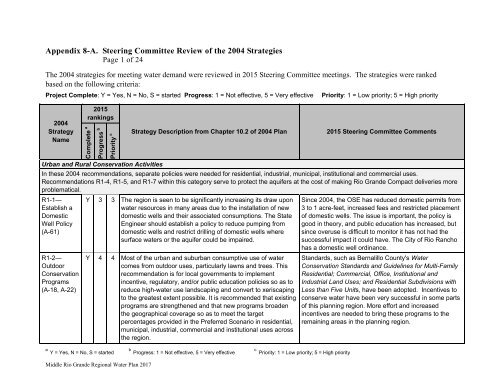Middle Rio Grande Regional Water Plan
2iUWd5b
2iUWd5b
You also want an ePaper? Increase the reach of your titles
YUMPU automatically turns print PDFs into web optimized ePapers that Google loves.
Appendix 8-A. Steering Committee Review of the 2004 Strategies<br />
Page 1 of 24<br />
The 2004 strategies for meeting water demand were reviewed in 2015 Steering Committee meetings. The strategies were ranked<br />
based on the following criteria:<br />
Project Complete: Y = Yes, N = No, S = started Progress: 1 = Not effective, 5 = Very effective Priority: 1 = Low priority; 5 = High priority<br />
2004<br />
Strategy<br />
Name<br />
2015<br />
rankings<br />
Complete a<br />
Progress b<br />
Priority c<br />
Strategy Description from Chapter 10.2 of 2004 <strong>Plan</strong><br />
a Y = Yes, N = No, S = started<br />
b Progress: 1 = Not effective, 5 = Very effective<br />
c Priority: 1 = Low priority; 5 = High priority<br />
2015 Steering Committee Comments<br />
Urban and Rural Conservation Activities<br />
In these 2004 recommendations, separate policies were needed for residential, industrial, municipal, institutional and commercial uses.<br />
Recommendations R1-4, R1-5, and R1-7 within this category serve to protect the aquifers at the cost of making <strong>Rio</strong> <strong>Grande</strong> Compact deliveries more<br />
problematical.<br />
R1-1—<br />
Establish a<br />
Domestic<br />
Well Policy<br />
(A-61)<br />
R1-2—<br />
Outdoor<br />
Conservation<br />
Programs<br />
(A-18, A-22)<br />
Y 3 3 The region is seen to be significantly increasing its draw upon<br />
water resources in many areas due to the installation of new<br />
domestic wells and their associated consumptions. The State<br />
Engineer should establish a policy to reduce pumping from<br />
domestic wells and restrict drilling of domestic wells where<br />
surface waters or the aquifer could be impaired.<br />
Y 4 4 Most of the urban and suburban consumptive use of water<br />
comes from outdoor uses, particularly lawns and trees. This<br />
recommendation is for local governments to implement<br />
incentive, regulatory, and/or public education policies so as to<br />
reduce high-water use landscaping and convert to xeriscaping<br />
to the greatest extent possible. It is recommended that existing<br />
programs are strengthened and that new programs broaden<br />
the geographical coverage so as to meet the target<br />
percentages provided in the Preferred Scenario in residential,<br />
municipal, industrial, commercial and institutional uses across<br />
the region.<br />
Since 2004, the OSE has reduced domestic permits from<br />
3 to 1 acre-feet, increased fees and restricted placement<br />
of domestic wells. The issue is important, the policy is<br />
good in theory, and public education has increased, but<br />
since overuse is difficult to monitor it has not had the<br />
successful impact it could have. The City of <strong>Rio</strong> Rancho<br />
has a domestic well ordinance.<br />
Standards, such as Bernalillo County's <strong>Water</strong><br />
Conservation Standards and Guidelines for Multi-Family<br />
Residential; Commercial, Office, Institutional and<br />
Industrial Land Uses; and Residential Subdivisions with<br />
Less than Five Units, have been adopted. Incentives to<br />
conserve water have been very successful in some parts<br />
of this planning region. More effort and increased<br />
incentives are needed to bring these programs to the<br />
remaining areas in the planning region.<br />
<strong>Middle</strong> <strong>Rio</strong> <strong>Grande</strong> <strong>Regional</strong> <strong>Water</strong> <strong>Plan</strong> 2017


